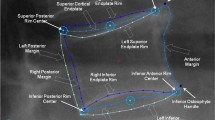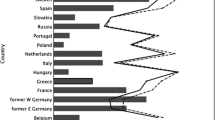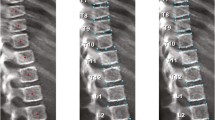Abstract
Summary
Our approach for the quantitative identification of vertebral deformity (standardised quantitative morphometry, SQM) reduces problems associated with obtaining reference intervals from populations with high prevalence of fracture. In women with osteoporosis, agreement with radiological diagnosis (surrogate gold standard) was better for SQM than QM using the Eastell-Melton method.
Introduction
Use of reference intervals for quantitative vertebral morphometry (QM) derived by statistical trimming can be problematic in reference populations with high prevalence of deformity. We have developed a modified approach known as standardised quantitative morphometry (SQM), whereby vertebral height is standardised to eliminate variation between individuals. The aims of this study were to compare SQM to QM (Eastell-Melton method) for identification of prevalent vertebral deformities, using qualitative radiological diagnosis as the gold standard, and automate the process.
Methods
Our study populations were a clinic-based sample of 80 women ages 48 to 87 years with a high prevalence of vertebral deformity and a general practice (GP)-based sample of 372 women ages 50 to 85 years. Agreement with the gold standard was tested for SQM and QM.
Results
Agreement was better for SQM (κ = 0.80) than for QM (κ = 0.14) in the clinic sample using clinic-based reference data. The agreement was improved for QM using the GP-based reference data, κ = 0.63. In the GP population, agreement was good for both SQM and QM (κ = 0.59 and 0.54 respectively).
Conclusions
In our population with a high prevalence of vertebral fracture, SQM performs better than the Eastell-Melton method.


Similar content being viewed by others
References
Barnett E, Nordin BEC (1960) The radiologic diagnosis of osteoporosis: a new approach. Clin Radiol 11:166–174
Reshef A, Schwartz A, Ben-Menachem Y et al (1971) Radiologic osteoporosis: Correlation with dietary and biochemical findings. J Am Geriatr Soc 19:391–402
Jensen KK, Tougaard L (1981) A simple x-ray method for monitoring progress of osteoporosis. Lancet 2:19–20
Minne HW, Leidig G, Wuster C et al (1988) A newly developed spine deformity index (SDI) to quantitate vertebral crush fractures in patients with osteoporosis. Bone Miner 3:335–349
Hedlund LR, Gallagher JC (1988) Vertebral morphometry in diagnosis of spinal fractures. Bone Miner 5:59–67
Melton LJ III, Kan SH, Frye MA et al (1989) Epidemiology of vertebral fractures in women. Am J Epidemiol 129:1000–1011
Davies KM, Recker RR, Heaney RP (1989) Normal vertebral dimensions and normal variation in serial measurements of vertebrae. J Bone Miner Res 4:341–349
Eastell R, Cedel SL, Wahner HW et al (1991) Classification of vertebral fractures. J Bone Miner Res 6:207–215
Sauer P, Leidig G, Minne H et al (1991) Spine deformity index (SDI) versus other objective procedures of vertebral fracture identification in patients with osteoporosis: a comparative study. J Bone Miner Res 6:227–238
McCloskey EV, Spector TD, Eyres KS et al (1993) The assessment of vertebral deformity. A method for use in population studies and clinical trials. Osteoporos Int 3:138–147
Hurxthal LM, Vose GP, Dotter WE (1969) Densitometric and visual observations of spinal radiographs. Geriatrics 24:93–106
Genant HK, Jergas M, Palermo L et al (1996) Comparison of semiquantitative visual and quantitative morphometric assessment of prevalent and incident vertebral fractures in osteoporosis. The Study of Osteoporotic Fractures Research Group. J Bone Miner Res 11:984–996
Kanis JA, McCloskey EV, Khan S et al (1993) What is a vertebral fracture? In: Christiansen C, Riis B (eds) Proceedings of the Fourth International Symposium on Osteoporosis and Consensus Development Conference. Handelstrykkeriet Aalborg ApS, Aalborg, pp 26–28
Leidig G, Storm T, Genant HK et al (1990) Comparison of two methods to assess vertebral fractures. In: Christiansen C, Overgaard K (eds) Osteoporosis Copenhagen: Osteopress ApS, pp 626–628, 1990
Wu CY, Li J, Jergas M et al (1995) Comparison of semiquantitative and quantitative techniques for the assessment of prevalent and incident vertebral fractures. Osteoporos Int 5:354–370
Pak CYC, Ho A, Poindexter J et al (1996) Quantitation of incident spinal fractures: comparison of visual detection with quantitative morphometry. Bone 18:349–353
Ross PD, Davis JW, Epstein RS et al (1992) Ability of vertebral dimensions from a single radiograph to identify fractures. Calcif Tissue Int 51:95–99
Davies KM, Recker RR, Heaney RP (1993) Revisable criteria for vertebral deformity. Osteoporos Int 3:265–270
Hedlund LR, Gallagher JC, Meeger C et al (1989) Change in vertebral shape in spinal osteoporosis. Calcif Tissue Int 44:168–172
Adami S, Gatti D, Rossini M et al (1992) The radiological assessment of vertebral osteoporosis. Bone 13:S33–S36
Banna M (1985) Clinical radiology of the spine and spinal cord. Aspen Systems Corporation, Maryland, p 388
Leidig-Bruckner G, Limberg B, Felsenberg D et al (2000) Sex difference in the validity of vertebral deformities as an index of prevalent vertebral osteoporotic fractures: a population survey of older men and women. Osteoporosis Int 11(2):102–119
Melton LJ, Lane AW, Cooper C et al (1993) Prevalence and incidence of vertebral deformities. Osteoporos Int 3:113–119
Black DM, Cummings SR, Stone K et al (1991) A new approach to defining normal vertebral dimensions. J Bone Miner Res 6:883–892
Black DM, Palermo L, Nevitt MC et al (1995) Comparison of methods for defining prevalent vertebral deformities: the study of osteoporotic fractures. J Bone Miner Res 10:890–902
Jiang G, Barrington NA, Eastell R (1999) Endplate angle approach for the quantitative identification of minor endplate vertebral deformities. J Bone Miner Res 14(Suppl 1):S496
Osman AA, Bassiouni H, Koutri R et al (1994) Aging of the thoracic spine: distinction between wedging in osteoarthritis and fracture in osteoporosis- a cross-sectional and longitudinal study. Bone 15(4):437–442
Zebaze RM, Maalouf G, Wehbe J et al (2004) The varying distribution of intra- and inter-vertebral height ratios determines the prevalence of vertebral fractures. Bone 35(2):348–356
Cummings SR et al (1995) National Osteoporosis Foundation Working Group on Vertebral Fractures. Report: assessing vertebral fractures. J Bone Miner Res 10:518–523
Genant K, Wu CY, Kuijk CV et al (1993) Vertebral fracture assessment using a semiquantitative technique. J Bone Miner Res 8:1137–1148
Melton LJ 3rd, Wenger DE, Atkinson EJ et al (2006) Influence of baseline deformity definition on subsequent vertebral fracture risk in postmenopausal women. Osteoporos Int 17(7):978–985
O’Neill TW, Felsenberg D, Varlow J (1996) The prevalence of vertebral deformity in European men and women: the European Vertebral Osteoporosis Study. J Bone Miner Res 11:1010–1018
Peel NFA, Johnson A, Smith TWD et al (1993) Impact of anomalous vertebral segmentation on measurements of bone mineral density. J Bone Miner Res 8:719–723
Ferrar L, Jiang G, Barrington NA et al (2000) Identification of vertebral deformities in women: comparison of radiological assessment and quantitative morphometry using morphometric radiography and morphometric x-ray absorptiometry. J Bone Miner Res 15(3):575–585
Altman DG (1991) Practical statistics for medical research. Chapman and Hall, London, UK
Jiang G, Eastell R, Barrington NA et al (2004) Comparison of methods for the visual identification of prevalent vertebral fracture in osteoporosis. Osteoporos Int 15(11):887–896, Nov
Acknowledgements
We would like to thank Dr. Yungui Zheng for his help in writing the software for use in Matlab. We acknowledge the doctors and nurses in the Metabolic Bone Unit, Northern General Hospital, Sheffield, in the recruiting of patients for the clinic-based sample, and the assistance of Dr. Diana Greenfield in the recruiting of patients for the GP-based sample.
Author information
Authors and Affiliations
Corresponding author
Rights and permissions
About this article
Cite this article
Jiang, G., Ferrar, L., Barrington, N.A. et al. Standardised quantitative morphometry: a modified approach for quantitative identification of prevalent vertebral deformities. Osteoporos Int 18, 1411–1419 (2007). https://doi.org/10.1007/s00198-007-0376-2
Received:
Accepted:
Published:
Issue Date:
DOI: https://doi.org/10.1007/s00198-007-0376-2




